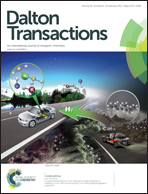Crystal structure and photoluminescence of two europium compounds with phenoxyacetic acid and 2,4,6-tri(2-pyridyl)-s-triazine†
Abstract
Two novel crystal compounds of Eu3+ and Gd3+/Eu3+ with phenoxyacetic acid (HPOA) and 2,4,6-tri(2-pyridyl)-s-triazine (TPTZ) have been synthesized. The two compounds are characterized by elemental analysis, rare earth coordination titrations, molar conductivity measurements, UV-vis absorption spectroscopy and IR spectroscopy. The crystal structures of compounds 1 Eu2(TPTZ)2(POA)6·2CH3OH and 2 EuGd(TPTZ)2(POA)6·2CH3OH were determined by single-crystal X-ray diffraction. The two monocrystals belong to the triclinic system and space group P![[1 with combining macron]](https://www.rsc.org/images/entities/char_0031_0304.gif) with the following unit cell parameters: a = 12.2448(10), 12.2476(6) Å; b = 13.2214(11), 13.2260(7) Å; c = 13.5248(12), 13.5210(7) Å; α = 74.8544(15), 74.8810(10)°; β = 83.0605(16), 83.0465(8)°; γ = 87.1996(14), 87.2126(8)°; V = 2097.7(7), 2098.5(19) Å3 and Z = 1, respectively. They are both dinuclear: one is homonuclear and the other is heteronuclear. Each metal ion is coordinately bonded to three nitrogen atoms of one TPTZ and seven oxygen atoms of three phenoxyacetate ions. Furthermore, there exist two coordinate forms between C6H5OCH2COO− and metal ions. One is chelating bidentate and the other is chelating and bridge coordinating. The triplet energy level of phenoxyacetic acid was measured, which is approximately 22 500 cm−1, indicating that the lowest excitation state energy level of Eu(III) and the triplet state energy level of phenoxyacetic acid match well with each other. The luminescent emission intensity of both compounds was very strong. Besides, the results indicate that the luminescent emission intensity, luminescence lifetimes and the emission quantum efficiencies of Gd3+/Eu3+ compound 2 are remarkably superior to those of compound 1, respectively. This phenomenon may mainly result from the decrease of the concentration quenching effect of Eu3+ ions, and the intramolecular energy transfer from the ligands coordinated with Gd3+ ions to Eu3+ ions.
with the following unit cell parameters: a = 12.2448(10), 12.2476(6) Å; b = 13.2214(11), 13.2260(7) Å; c = 13.5248(12), 13.5210(7) Å; α = 74.8544(15), 74.8810(10)°; β = 83.0605(16), 83.0465(8)°; γ = 87.1996(14), 87.2126(8)°; V = 2097.7(7), 2098.5(19) Å3 and Z = 1, respectively. They are both dinuclear: one is homonuclear and the other is heteronuclear. Each metal ion is coordinately bonded to three nitrogen atoms of one TPTZ and seven oxygen atoms of three phenoxyacetate ions. Furthermore, there exist two coordinate forms between C6H5OCH2COO− and metal ions. One is chelating bidentate and the other is chelating and bridge coordinating. The triplet energy level of phenoxyacetic acid was measured, which is approximately 22 500 cm−1, indicating that the lowest excitation state energy level of Eu(III) and the triplet state energy level of phenoxyacetic acid match well with each other. The luminescent emission intensity of both compounds was very strong. Besides, the results indicate that the luminescent emission intensity, luminescence lifetimes and the emission quantum efficiencies of Gd3+/Eu3+ compound 2 are remarkably superior to those of compound 1, respectively. This phenomenon may mainly result from the decrease of the concentration quenching effect of Eu3+ ions, and the intramolecular energy transfer from the ligands coordinated with Gd3+ ions to Eu3+ ions.


 Please wait while we load your content...
Please wait while we load your content...